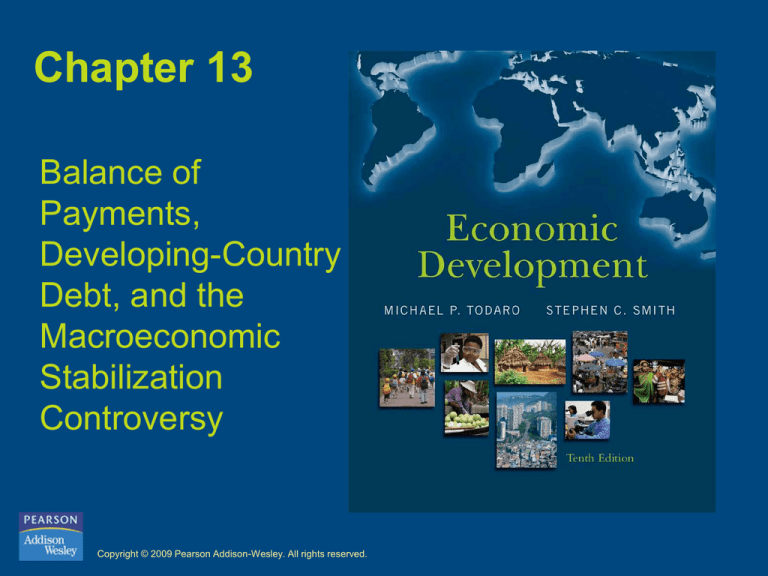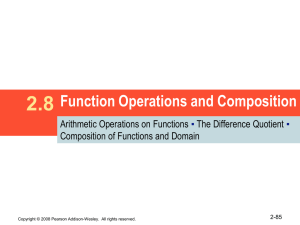
Chapter 13
Balance of
Payments,
Developing-Country
Debt, and the
Macroeconomic
Stabilization
Controversy
Copyright © 2009 Pearson Addison-Wesley. All rights reserved.
The Balance of Payments
• The current account: net flow of
merchandise trade
• The capital account: net flow of
financial capital
Copyright © 2009 Pearson Addison-Wesley. All rights reserved.
13-2
The Balance of Payments
The current account:
• Exports (+)
• Imports (-)
• Investment income (+)
• Debt-service payments (-)
• Net remittances and transfers (+)
Copyright © 2009 Pearson Addison-Wesley. All rights reserved.
13-3
The Balance of Payments
The capital account:
• Direct private investment (+)
• Foreign loans (+)
• Foreign assets of domestic banks
(-)
• Resident capital outflow (-)
Copyright © 2009 Pearson Addison-Wesley. All rights reserved.
13-4
Copyright © 2009 Pearson Addison-Wesley. All rights reserved.
13-5
Copyright © 2009 Pearson Addison-Wesley. All rights reserved.
13-6
The Balance of Payments
• The balance of payments position:
– Surplus: inflows > outflows
– Deficit: outflows > inflows
• Consequence:
– Surplus: increase in cash reserves account
– Deficit: decrease in cash reserves account
Copyright © 2009 Pearson Addison-Wesley. All rights reserved.
13-7
Payments Balances on Current
Account, 1980–2006 (billions of
dollars)
Copyright © 2009 Pearson Addison-Wesley. All rights reserved.
13-8
Consequences of BOP Deficit
• Reduce cash reserves account
• Inhabit imports: impose tariffs/quotas;
foreign exchange devaluation
• Increase exports: foreign exchange
devaluation
Copyright © 2009 Pearson Addison-Wesley. All rights reserved.
13-9
Consequences of BOP Deficit
• Impose restrictive fiscal and monetary policy
– Reduce income expansion to lower import growth
– Reduce inflation for exports to compete internationally
• Attract direct foreign investment
• Receive a greater share of the IMF’s “paper gold”
known as the Special Drawing Rights (SDRs)
• Increase external debt
Copyright © 2009 Pearson Addison-Wesley. All rights reserved.
13-10
Third World Debt Crisis
• The accumulation of external debt Since
early 1980s
• Allocation of a larger percentage of the GDP
(from export earnings) to service external
debt
• Scarcity of development funds: lack of
investment in physical, human, and social
capital
Copyright © 2009 Pearson Addison-Wesley. All rights reserved.
13-11
Dimensions of the LDC Debt
Burden, 1970–2008
Copyright © 2009 Pearson Addison-Wesley. All rights reserved.
13-12
Severely Indebted Countries
• Large outstanding debt
• Debt as a large percentage of GDP and
exports
• High debt service-to-GDP (or GNI) ratio
• High debt service-to-exports ratio
Copyright © 2009 Pearson Addison-Wesley. All rights reserved.
13-13
Copyright © 2009 Pearson Addison-Wesley. All rights reserved.
13-14
External Debt Accumulation
Define Fn as the capital inflow (i.e., the
amount of debt accumulation)
Fn = dD
D = total external debt
d = percentage increase in total external
debt
Copyright © 2009 Pearson Addison-Wesley. All rights reserved.
13-15
External Debt Accumulation
• Define BT as the basic transfer and
r as average interest rate charged
on external debt
BT = dD – rD = (d - r)D
- dD: external debt
- rD: amortized debt
- d>r: debt accumulation
Copyright © 2009 Pearson Addison-Wesley. All rights reserved.
13-16
The Debt Crisis
• Rising d and d > r
• Switching from fixed, concessional rates to
short-term, variable rates
• BOP deficits as LDCs’ commodity prices
plummeted
Copyright © 2009 Pearson Addison-Wesley. All rights reserved.
13-17
The Debt Crisis
• Global recession, reducing demand for LDC
exports
• Lack of confidence in LDCs’ ability to repay
foreign loans
• Substantial amount of capital flight from the
LDCs
Copyright © 2009 Pearson Addison-Wesley. All rights reserved.
13-18
Petrodollars and Third World
Debt
The OPEC (i.e., Qatar, Saudi Arabia,
Kuwait):
• Exports oil to LDCs and MDCs
• Deposits some of their export earnings in
Western banks
• Provides grants and interest-free loans to
LDCs
Western Banks:
Copyright © 2009 Pearson Addison-Wesley. All rights reserved.
13-19
The Mechanics of Petrodollar
Recycling
Copyright © 2009 Pearson Addison-Wesley. All rights reserved.
13-20
The IMF Stabilization Policy
• Remove foreign exchange and import controls
• Use a floating foreign exchange rate
• Adopt stringent anti-inflationary policy
– Increase interest rates
– Reduce budget deficits
– Control wage increases
– Eliminate price subsidies
• Invite foreign investment and improve
economic openness
Copyright © 2009 Pearson Addison-Wesley. All rights reserved.
13-21
The IMF Stabilization Policy
Success in LDCs:
• Reduce inflation
• Improve balance of payments
• Eliminate parallel exchange rates
• Improve economic efficiency
Copyright © 2009 Pearson Addison-Wesley. All rights reserved.
13-22
The IMF Stabilization Policy
Failure in LDCs:
• Double standards
– Harsh adjustments for the LDCs
– No adjustment for the MDCs
• Lending agencies
–
–
–
–
Agents of international capitalism
Increase LDC dependence and poverty
Prefer short-term to long-term developmental loans
Provide funds for corrupt LDC governments
Copyright © 2009 Pearson Addison-Wesley. All rights reserved.
13-23
Global Dimensions of LDC Debt
• Restructuring of short-term to long-term loans
• Debt forgiveness to selected LDCs if they
continue to use IMF stabilization policy
• Debt-for-equity swap: banks exchange loans
for ownership of domestic industries
• Debt-for-nature swap: MDC government
forgive loans if LDCs invest in preserving the
environment
Copyright © 2009 Pearson Addison-Wesley. All rights reserved.
13-24
Has the Debt Crisis Disappeared?
No! Debt crisis is just postponed!
• LDCs continue to borrow
• LDCs continue to make large debt service
payments
• In addition to the severely indebted LDCs,
countries in Africa are greatly dependent on
external debt
Copyright © 2009 Pearson Addison-Wesley. All rights reserved.
13-25







